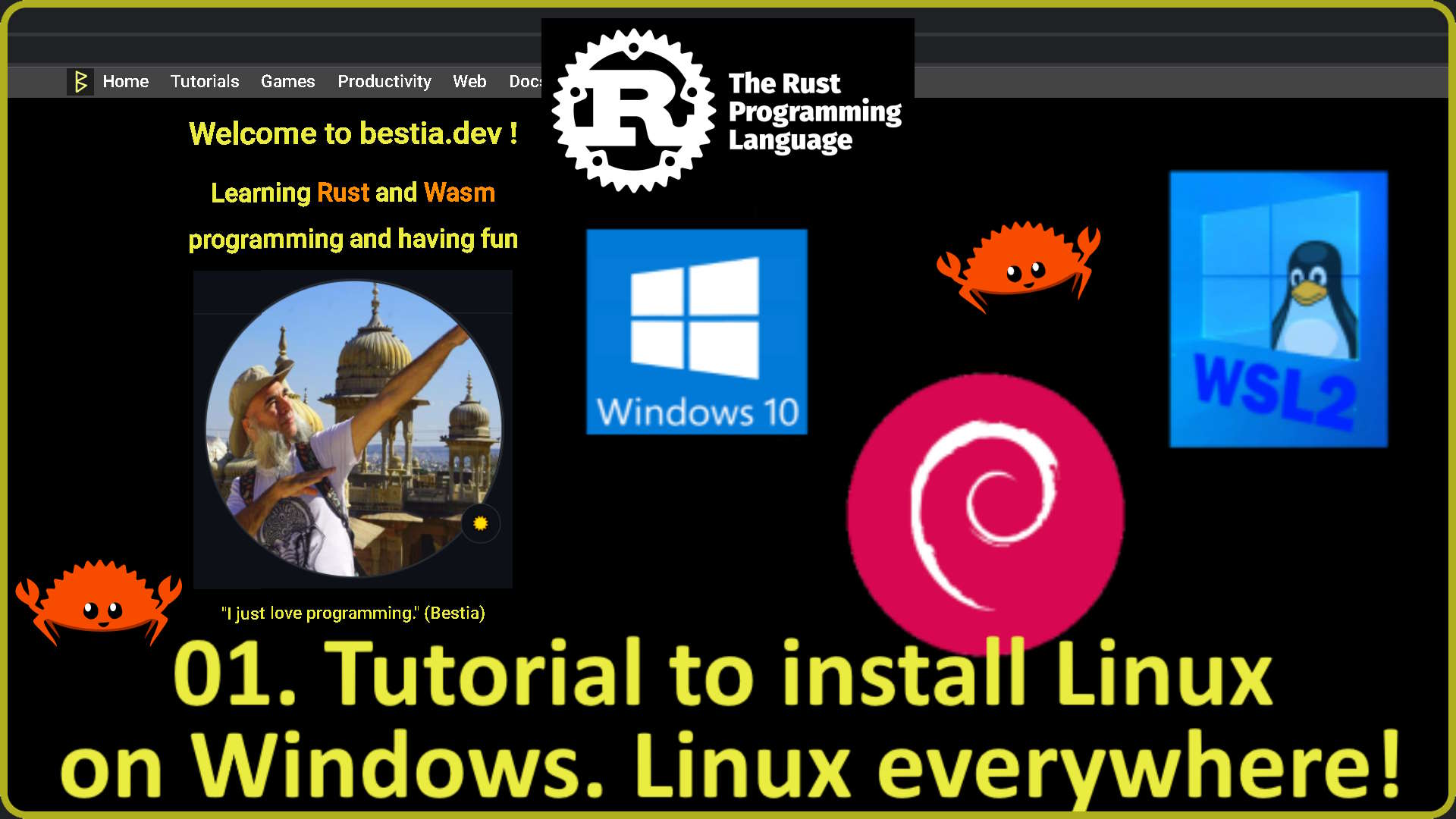01. Tutorial to install Linux on Windows. Linux everywhere! (win10_wsl2_debian11) (2022-03)
version: 2024.326.1347 date: 2024-03-26 author: bestia.dev repository: GitHub
 win10_wsl2_debian11 is a member of the CRUSTDE-ContainerizedRustDevEnv project.
win10_wsl2_debian11 is a member of the CRUSTDE-ContainerizedRustDevEnv project.
Hashtags: #rustlang #tutorial
My projects on GitHub are more like a tutorial than a finished product: bestia-dev tutorials.
For 30 years of my professional life, I programmed in Windows. It was good.
I am on a long vacation now and is time to learn something new.
This project has also a YouTube video tutorial. Watch it:
My conclusion is that Windows (and MacOS) should just die a long death and be replaced by Linux.
Microsoft obviously concluded the same, therefor they introduced WSL (Windows Subsystem for Linux). Now we can run more and more Linux programs inside Windows. So Windows is less and less interesting to programmers.
MacOS and iOS are already similar to Linux because they are based on BSD, a cousin of Unix.
Android is basically a bastard child of Linux and Google.
Almost all the web servers and servers in the cloud are Linux today.
So today it makes sense to do all the programming only for Linux.
The "elephant in the room" is the GUI. Every OS has on purpose made the GUI different and completely incompatible. Sadly!
But we have a strong international standard for GUI that works literally everywhere: it is HTML+CSS+JavascriptEngine.
I explicitly didn't say Javascript, let's call it by its true name ECMAScript because it is an abomination.
Fortunately, we have now WebAssembly abbreviated as WASM to save the day.
We can finally make client programs for the browser in some "normal" programming languages like Rust and many others.
Win10 is so ubiquitous that I have nothing interesting to say. It works just fine with all the drivers and peripherals and it comes preinstalled on most of the notebooks. We can say it is a winning OS in the desktop/notebook segment. In the enterprise world, Microsoft still has a firm grip with its Office suite. Blue-collar workers are just hooked to it like drug addicts even when there are good alternatives.
But Windows lost completely in the server segment and shamefully in the smartphone segment.
We "must" use it on notebooks because of the drivers, but it is slowly dying.
I don't have any opinion of Win11. Microsoft "promised" that Win10 was the last version of Windows and that the number would last forever and be free. In the background, there will be minor and major updates. They broke their promise. I think nobody really loves Win11.
It looks more like they are trying to push people away from Windows on purpose.
WSL2 is a revolution. With it, I have a lightweight virtual machine with a true Linux kernel. On my Lenovo notebook, I have Win10 and it works fine with all the drivers and peripherals, but now I have also Linux, so I can do some serious programming for the Linux cloud servers. Not just one Linux, I can have multiple Linux OS simultaneously on the same machine because they run in a VM.
Let's install/enable it on Win10:
https://docs.microsoft.com/en-us/windows/wsl/install-win10#update-to-wsl-2
Open Windows git-bash Run as Administrator:
export MSYS_NO_PATHCONV=1
dism.exe /online /enable-feature /featurename:Microsoft-Windows-Subsystem-Linux /all /norestart
# restart and update to WSL2
dism.exe /online /enable-feature /featurename:VirtualMachinePlatform /all /norestart
unset MSYS_NO_PATHCONV
# Set WSL2 as default
wsl --set-default-version 2
# I can update the wsl now
wsl --updateIf needed restart Windows for this changes to be 100% in effect.
Debian is considered the grandfather of Linux-based operating systems. The Linux OSes are called "distribution" or "distro". All of them have in common the Linux Kernel developed firstly by Linux Torvald, but they differ in other components that make an Operating system.
Debian is conservative in its release cycle to ensure high stability. Some say that it is boringly stable ;-) I am old and I like "stable".
Some distros are derived from Debian and share a lot with it. Everybody has heard of Ubuntu, a big Linux popularity success for desktops.
The new version of Debian is 11. Every version has its unique name, version 11 is called Bullseye. Nice name.
Use the Microsoft Store to install Debian inside WSL2:
https://www.microsoft.com/en-us/p/debian/9msvkqc78pk6
or in Windows git-bash a few lines:
# list the distros
wsl --list --online
# install Debian
wsl --install -d DebianIt takes a minute! Now we can open the Debian bash terminal using the provided "Debian" icon in Start Menu. This Debian is without the GUI desktop. We could additionally install it, but we will rarely need it. A lot of Linux programs for programmers work just fine in the non-GUI mode inside a bash terminal.
The Windows user is automatically also a Debian user.
In the bash terminal we can type these commands to update/upgrade Debian packages:
sudo apt update
sudo apt -y full-upgrade
cat /etc/debian_version
# 12.5WSL2 works very fast with its own filesystem.
From Linux, we can access the win10 filesystem mounted on /mnt/c/, but this is very slow.
From Windows, we can access the Linux files on \\wsl$\Debian\. But sometimes when we copy files, we get an additional annoying file "*.attr" for attributes that differ on the 2 filesystems. I always delete it.
Debian is now 12 bookworm. But that doesn't change much. It is easy to uninstall the old Debian and install the new one just with the same commands.
First, store the important configuration of Debian somehow and restore it later.
The same commands will install the latest version. That takes just a minute! Great!.
I configured nano as my default editor in the bash terminal for simple text editing. It is easy to use.
I like to use the mouse:
- Select text with the mouse to copy. Nothing to click, just select.
- Right-click to paste.
- mouse wheel to scroll up and down
This works with the Windows clipboard and is used to transfer text from and to the bash terminal.
This useful functionality comes from the Wezterm terminal and not from the nano editor.
Don't use set mouse in file ~/.nanorc because it will disable this useful terminal mouse functionality.
Editor nano important functions:
- Arrows keys, pgup, pgdown, home and end move the terminal cursor intuitively
- Delete and backspace work intuitively
Ctrl-Kto delete a line. Press longer to delete many lines.Ctrl-Osave fileCtrl-Xto exit
My main OS Windows can see the files inside WSL using paths like this: \\wsl$\Debian\home\ or \\wsl.localhost\Debian\home\. I think this is fine. The host can see the guest.
I don't like that programs in WSL can see the files of my host OS Windows. The win drives are mounted like /mnt/c/, /mnt/d/,... It is called WSL auto-mount. I want to disable that.
For "security" I don't want WSL to see Windows drives, folders and files by default. It is never good that the guest can see the host. This access is even read/write. Bad.
There is a half-baked solution from Microsoft, but workable for my use case.
A malicious actor could still mount any Windows folder he wants if he gets admin privilege in WSL because then he can change the /etc/wsl.conf file.
This is not a good sandbox. It just makes exploits a little bit trickier, but possible nonetheless.
microsoft/WSL#7236
Microsoft always does everything unsafe by default! On purpose. Bad Microsoft!
First, disable the virtio9p protocol that is used by WSL to access the files in Windows. At least I hope I understood that right.
In Windows git-bash create the file with the command:
code ~/.wslconfig[wsl2]
# disable wsl from accessing windows files
virtio9p=false
Second, write the file in the Debian bash with nano:
sudo nano /etc/wsl.conf# Automatically mount Windows drive when the distribution is launched
[automount]
# disable auto-mounting of win drives
enabled = false
# process fstab entries to allow some folders to be mounted
mountFsTab = true
# disable launching windows exe files
[interop]
enabled = false
appendWindowsPath = false
For the changes to take effect, in Windows git-bash shutdown WSL with:
wsl --shutdownAfter restart, the win drives are not automounted anymore, but the mounting points are still here.
In Debian bash:
ls /mnt
# c d wsl wslg
sudo rmdir /mnt/c
sudo rmdir /mnt/d
# mounting points c and d are now deleted
ls /mnt
# wsl wslgNow when starting WSL I get a stupid error:
<3>WSL (9) ERROR: UtilTranslatePathList:2866: Failed to translate C:\Users\luciano
And I don't know from where it comes from.
The appendWindowsPath is already set to false. Usually, this is the main reason for errors like that.
Git and SSH are essential to developers. We need to securely access our remote repositories on GitHub and our production Web servers. All over SSH. The installation of Git brings SSH with it. Install Git in Debian:
sudo apt install -y git
git --version
# git version 2.39.2
ssh -V
# OpenSSH_9.2p1 Debian-2+deb12u2, OpenSSL 3.0.11 19 Sep 2023# config git globally
git config --global user.name "Your Name"git config --global user.email "[email protected]"# for windows only:
git config --global core.eol lf
git config --global core.autocrlf input
# I like to use the nano editor in the terminal
git config --global core.editor "nano"
git config --global -lConfig SSH:
mkdir -vp ~/.ssh
chmod 700 ~/.ssh
# From Windows from your encrypted vault, copy your existing ssh keys (private and public) for Github and your web server into ~/.ssh. Mine are called github_com_git_ssh_1 and bestia_dev_luciano_bestia_ssh_1.
# Windows can read/write the Linux Filesystem. Linux should NOT read/write the Windows file system. Host->Guest ok. Guest->Host no-no.# config appropriate security for the private key files
sudo chmod 600 ~/.ssh/github_com_git_ssh_1
sudo chmod 600 ~/.ssh/bestia_dev_luciano_bestia_ssh_1Create the file ~/.ssh/config with this content:
nano ~/.ssh/configCreate the file ~/.ssh/sshadd.sh with this content
nano ~/.ssh/sshadd.shTo activate the ssh-agent and config other stuff on start of bash terminal,
copy this content to file ~/.bashrc.
First, use Ctrl-K multiple times to delete all existing lines.
nano ~/.bashrcBash makes a horrible sound when using auto-completion.
Kill auto-completion horrible sound:
printf "set bell-style none\n" >> ~/.inputrcIf you want a fresh new installation of Debian it is easy to remove the existing one in Windows git-bash.
Warning: You will lose all the content.
# get the exact distro name
wsl -l -v
wsl --unregister DebianIf you need to remove WSL2 open Windows git-bash Run as Administrator.
Warning: You will lose all the content.
MSYS_NO_PATHCONV=1 dism.exe /online /disable-feature /featurename:Microsoft-Windows-Subsystem-LinuxAfter putting the laptop to sleep, sometimes the WSL2 does not work right. When I need to use localhost or 127.0.0.1 connection from Win10 to a Linux program, the connection is broken. I have to restart the WSL in Windows git-bash Run as Administrator with
Get-Service LxssManager | Restart-Service.
Not nice and very difficult to discover because WSL2 is running just fine, except for this.
Sometimes the content of an external disk is completely wrong when looked at from the WSL2. It is obsolete, something that is a remnant of other external disks. I think I unmounted the mnt/d in Linux and then mounted it back to solve the problem.
My git repository inside WSL2 got corrupted. It looks like this happens to many people on WSL2.
The cure is:
# backup the repo first!
find .git/objects/ -type f -empty | xargs rm
git fetch -p
git fsck --fullMy open-source projects are free as a beer (MIT license).
I just love programming.
But I need also to drink. If you find my projects and tutorials helpful, please buy me a beer by donating to my PayPal.
You know the price of a beer in your local bar ;-)
So I can drink a free beer for your health :-)
Na zdravje! Alla salute! Prost! Nazdravlje! 🍻
//bestia.dev
//github.com/bestia-dev
//bestiadev.substack.com
//youtube.com/@bestia-dev-tutorials





